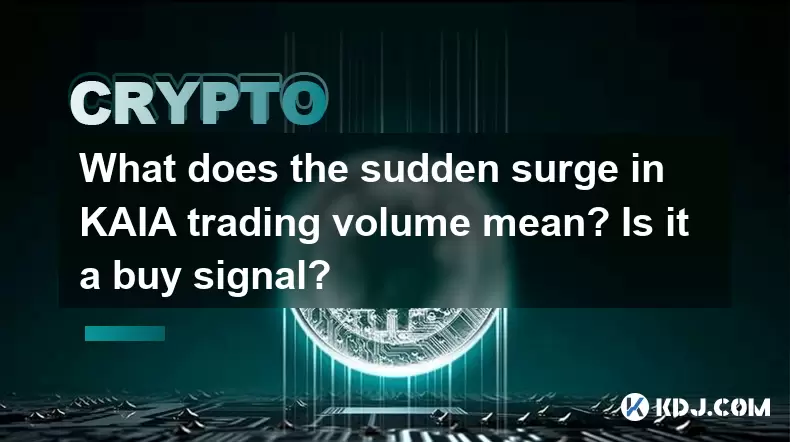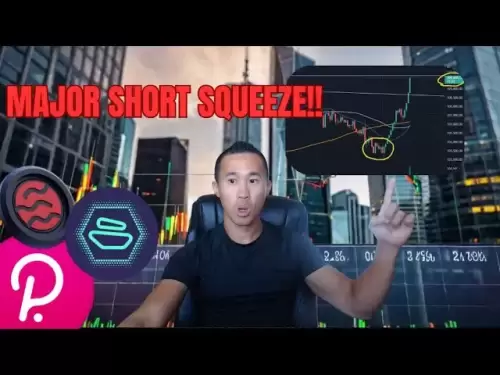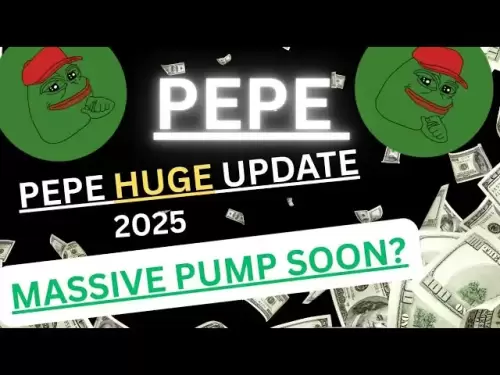-
 Bitcoin
Bitcoin $108,270.9768
2.07% -
 Ethereum
Ethereum $2,489.8066
2.50% -
 Tether USDt
Tether USDt $1.0004
0.01% -
 XRP
XRP $2.2035
0.66% -
 BNB
BNB $661.6608
2.32% -
 Solana
Solana $150.6425
2.13% -
 USDC
USDC $0.9999
-0.01% -
 TRON
TRON $0.2810
0.90% -
 Dogecoin
Dogecoin $0.1645
3.05% -
 Cardano
Cardano $0.5743
4.91% -
 Hyperliquid
Hyperliquid $38.8419
-0.15% -
 Bitcoin Cash
Bitcoin Cash $504.3134
-2.64% -
 Sui
Sui $2.8096
4.35% -
 Chainlink
Chainlink $13.3095
2.21% -
 UNUS SED LEO
UNUS SED LEO $8.9469
0.33% -
 Avalanche
Avalanche $17.9231
3.93% -
 Stellar
Stellar $0.2340
0.74% -
 Toncoin
Toncoin $2.8458
3.21% -
 Shiba Inu
Shiba Inu $0.0...01158
3.47% -
 Litecoin
Litecoin $86.0738
1.94% -
 Hedera
Hedera $0.1507
2.99% -
 Monero
Monero $319.8544
2.31% -
 Polkadot
Polkadot $3.4081
1.95% -
 Dai
Dai $1.0000
0.01% -
 Bitget Token
Bitget Token $4.5645
0.91% -
 Ethena USDe
Ethena USDe $1.0002
0.00% -
 Uniswap
Uniswap $7.2959
5.27% -
 Aave
Aave $272.4623
2.90% -
 Pepe
Pepe $0.0...09680
2.96% -
 Pi
Pi $0.4955
0.78%
What does the sudden surge in KAIA trading volume mean? Is it a buy signal?
The surge in KAIA's trading volume has sparked interest, but investors should analyze market context and potential manipulation before considering it a buy signal.
May 08, 2025 at 03:28 pm

The sudden surge in KAIA trading volume has caught the attention of many in the cryptocurrency community. KAIA, a relatively new token in the crypto space, has seen its trading volume spike dramatically over a short period. This phenomenon raises several questions among investors and traders: What does this surge signify? Is it a buy signal? To answer these questions, we need to delve deeper into the implications of trading volume, the context of KAIA's market, and the broader market sentiment.
Understanding Trading Volume
Trading volume refers to the number of shares or contracts traded in a security or market during a given period. In the context of cryptocurrencies, it represents the total number of coins traded within a specific timeframe. A sudden surge in trading volume can indicate several things. It might suggest increased interest in the asset, possibly due to new developments, positive news, or market speculation. Alternatively, it could be a sign of market manipulation or a coordinated effort to influence the price.
The Case of KAIA
KAIA, a token that has been gaining traction in the crypto market, recently experienced a significant increase in trading volume. To understand what this means, we need to look at the specific circumstances surrounding KAIA. KAIA's project aims to provide a decentralized platform for various applications, and its recent surge in volume could be linked to announcements or updates related to its development. For instance, if KAIA announced a new partnership or a significant upgrade to its platform, this could drive interest and increase trading activity.
Is the Surge a Buy Signal?
Determining whether a surge in trading volume is a buy signal requires careful analysis. A sudden increase in volume can indeed be a bullish indicator, suggesting that more investors are interested in the asset and are willing to buy it. However, it is crucial to consider other factors as well. For instance, if the volume surge is accompanied by a significant price increase, it might indicate strong buying pressure and could be a positive sign for potential investors.
On the other hand, if the volume surge is not supported by fundamental developments or if it appears to be driven by speculative trading, it might not be a reliable buy signal. Market sentiment plays a crucial role here. If the broader market is bullish and investors are looking for new opportunities, a surge in KAIA's volume could be seen as a positive sign. Conversely, if the market is bearish or if there are concerns about the sustainability of KAIA's project, the surge might be viewed with skepticism.
Analyzing the Data
To make an informed decision about whether the surge in KAIA's trading volume is a buy signal, it is essential to analyze the data thoroughly. Technical analysis can provide insights into the price movements and trading patterns of KAIA. For instance, if the volume surge is accompanied by a breakout from a key resistance level, it could be a strong bullish signal. Additionally, looking at the volume profile over time can help identify whether the surge is an anomaly or part of a broader trend.
Fundamental analysis is equally important. Investors should examine KAIA's project roadmap, team, and partnerships to assess its long-term potential. If the fundamentals are strong and the volume surge is supported by positive developments, it could be a more reliable buy signal.
The Role of Market Manipulation
It is also important to consider the possibility of market manipulation. In the cryptocurrency market, it is not uncommon for certain actors to artificially inflate trading volume to create the illusion of increased interest. This can be done through techniques such as wash trading, where an individual or group trades with themselves to boost volume figures. If there are suspicions of such activities surrounding KAIA, the surge in volume might not be a genuine buy signal.
Conclusion on the Surge in KAIA Trading Volume
In conclusion, the sudden surge in KAIA's trading volume is a complex phenomenon that requires careful analysis. While it can be a bullish indicator, it is not a definitive buy signal on its own. Investors should consider the broader market context, the specific circumstances surrounding KAIA, and the potential for market manipulation. By combining technical and fundamental analysis, investors can make more informed decisions about whether to buy KAIA based on its recent volume surge.
Frequently Asked Questions
Q: How can I verify the authenticity of the trading volume surge in KAIA?
A: To verify the authenticity of the trading volume surge in KAIA, you can use several methods. First, check multiple cryptocurrency exchanges to see if the volume surge is consistent across different platforms. Second, look for any news or announcements from KAIA's official channels that might explain the surge. Finally, use tools like blockchain explorers to analyze on-chain data and see if the volume surge is reflected in actual transactions.
Q: What other indicators should I look at besides trading volume to assess KAIA's potential?
A: Besides trading volume, you should consider several other indicators to assess KAIA's potential. These include price trends, moving averages, relative strength index (RSI), and on-chain metrics such as transaction volume and active addresses. Additionally, fundamental factors like the project's roadmap, team, partnerships, and community engagement are crucial for a comprehensive analysis.
Q: How can I protect myself from potential market manipulation when trading KAIA?
A: To protect yourself from potential market manipulation when trading KAIA, follow these steps:
- Diversify your portfolio: Don't put all your funds into one asset.
- Use stop-loss orders: Set stop-loss orders to limit potential losses.
- Stay informed: Keep up with news and developments related to KAIA and the broader crypto market.
- Use reputable exchanges: Trade on well-established and regulated exchanges to minimize the risk of manipulation.
- Monitor trading patterns: Be wary of sudden, unexplained spikes in volume or price, and investigate further before making trading decisions.
Disclaimer:info@kdj.com
The information provided is not trading advice. kdj.com does not assume any responsibility for any investments made based on the information provided in this article. Cryptocurrencies are highly volatile and it is highly recommended that you invest with caution after thorough research!
If you believe that the content used on this website infringes your copyright, please contact us immediately (info@kdj.com) and we will delete it promptly.
- XRP Price Targets $2.40 After Descending Channel Breakout: Is $40 Next?
- 2025-07-03 08:50:12
- All Blacks' Loose Forward Conundrum: New Faces and Familiar Battles
- 2025-07-03 08:30:12
- Bitcoin's Wild Ride: Open Interest, Institutional Bets, and Billions on the Line
- 2025-07-03 08:30:12
- Bitcoin, Strategy, & Profit: MSTR's Crypto Playbook and Trump's Digital Diversification
- 2025-07-03 08:50:12
- Bitcoin on the Brink: Active Supply Signals Potential Rally
- 2025-07-03 06:30:12
- Solana, XRP, SEI: Altcoin Titans and the Next Big Thing
- 2025-07-03 06:50:12
Related knowledge

How to customize USDT TRC20 mining fees? Flexible adjustment tutorial
Jun 13,2025 at 01:42am
Understanding USDT TRC20 Mining FeesMining fees on the TRON (TRC20) network are essential for processing transactions. Unlike Bitcoin or Ethereum, where miners directly validate transactions, TRON uses a delegated proof-of-stake (DPoS) mechanism. However, users still need to pay bandwidth and energy fees, which are collectively referred to as 'mining fe...

USDT TRC20 transaction is stuck? Solution summary
Jun 14,2025 at 11:15pm
Understanding USDT TRC20 TransactionsWhen users mention that a USDT TRC20 transaction is stuck, they typically refer to a situation where the transfer of Tether (USDT) on the TRON blockchain has not been confirmed for an extended period. This issue may arise due to various reasons such as network congestion, insufficient transaction fees, or wallet-rela...

How to cancel USDT TRC20 unconfirmed transactions? Operation guide
Jun 13,2025 at 11:01pm
Understanding USDT TRC20 Unconfirmed TransactionsWhen dealing with USDT TRC20 transactions, it’s crucial to understand what an unconfirmed transaction means. An unconfirmed transaction is one that has been broadcasted to the blockchain network but hasn’t yet been included in a block. This typically occurs due to low transaction fees or network congestio...

How to check USDT TRC20 balance? Introduction to multiple query methods
Jun 21,2025 at 02:42am
Understanding USDT TRC20 and Its ImportanceUSDT (Tether) is one of the most widely used stablecoins in the cryptocurrency market. It exists on multiple blockchain networks, including TRC20, which operates on the Tron (TRX) network. Checking your USDT TRC20 balance accurately is crucial for users who hold or transact with this asset. Whether you're sendi...

What to do if USDT TRC20 transfers are congested? Speed up trading skills
Jun 13,2025 at 09:56am
Understanding USDT TRC20 Transfer CongestionWhen transferring USDT TRC20, users may occasionally experience delays or congestion. This typically occurs due to network overload on the TRON blockchain, which hosts the TRC20 version of Tether. Unlike the ERC20 variant (which runs on Ethereum), TRC20 transactions are generally faster and cheaper, but during...

The relationship between USDT TRC20 and TRON chain: technical background analysis
Jun 12,2025 at 01:28pm
What is USDT TRC20?USDT TRC20 refers to the Tether (USDT) token issued on the TRON blockchain using the TRC-20 standard. Unlike the more commonly known ERC-20 version of USDT (which runs on Ethereum), the TRC-20 variant leverages the TRON network's infrastructure for faster and cheaper transactions. The emergence of this version came as part of Tether’s...

How to customize USDT TRC20 mining fees? Flexible adjustment tutorial
Jun 13,2025 at 01:42am
Understanding USDT TRC20 Mining FeesMining fees on the TRON (TRC20) network are essential for processing transactions. Unlike Bitcoin or Ethereum, where miners directly validate transactions, TRON uses a delegated proof-of-stake (DPoS) mechanism. However, users still need to pay bandwidth and energy fees, which are collectively referred to as 'mining fe...

USDT TRC20 transaction is stuck? Solution summary
Jun 14,2025 at 11:15pm
Understanding USDT TRC20 TransactionsWhen users mention that a USDT TRC20 transaction is stuck, they typically refer to a situation where the transfer of Tether (USDT) on the TRON blockchain has not been confirmed for an extended period. This issue may arise due to various reasons such as network congestion, insufficient transaction fees, or wallet-rela...

How to cancel USDT TRC20 unconfirmed transactions? Operation guide
Jun 13,2025 at 11:01pm
Understanding USDT TRC20 Unconfirmed TransactionsWhen dealing with USDT TRC20 transactions, it’s crucial to understand what an unconfirmed transaction means. An unconfirmed transaction is one that has been broadcasted to the blockchain network but hasn’t yet been included in a block. This typically occurs due to low transaction fees or network congestio...

How to check USDT TRC20 balance? Introduction to multiple query methods
Jun 21,2025 at 02:42am
Understanding USDT TRC20 and Its ImportanceUSDT (Tether) is one of the most widely used stablecoins in the cryptocurrency market. It exists on multiple blockchain networks, including TRC20, which operates on the Tron (TRX) network. Checking your USDT TRC20 balance accurately is crucial for users who hold or transact with this asset. Whether you're sendi...

What to do if USDT TRC20 transfers are congested? Speed up trading skills
Jun 13,2025 at 09:56am
Understanding USDT TRC20 Transfer CongestionWhen transferring USDT TRC20, users may occasionally experience delays or congestion. This typically occurs due to network overload on the TRON blockchain, which hosts the TRC20 version of Tether. Unlike the ERC20 variant (which runs on Ethereum), TRC20 transactions are generally faster and cheaper, but during...

The relationship between USDT TRC20 and TRON chain: technical background analysis
Jun 12,2025 at 01:28pm
What is USDT TRC20?USDT TRC20 refers to the Tether (USDT) token issued on the TRON blockchain using the TRC-20 standard. Unlike the more commonly known ERC-20 version of USDT (which runs on Ethereum), the TRC-20 variant leverages the TRON network's infrastructure for faster and cheaper transactions. The emergence of this version came as part of Tether’s...
See all articles

























































































